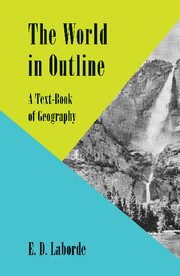Natural Regions
from PART V - SOUTH AMERICA
Published online by Cambridge University Press: 05 June 2016
Summary
The various combinations of natural conditions— relief, climate, and plant and animal life—enable the continent to be divided into twelve areas for closer study. They are as follows: (1) the lowlands of the Amazon and the Pacific coast of Colombia and Ecuador, (2) the equatorial highlands, (3) the highlands of Brazil and Guiana, (4) the lowlands of the north coast and the coast strip of southeast Brazil, (5) the West Indies, (6) the subtropical east coast, (7) the Andine foot-hills and the Pampas, (8) the cool east coast, (9) the temperate west coast, (10) the Mediterranean region, (11) the tropical west coast, and (12) the Andine toplands. The map on page 354 indicates their positions.
THE REGIONS
The Equatorial Lowlands. These include the lower parts of the huge basin of the River Amazon and the Pacific coast strip between the Gulfs of Guayaquil and Panama. The former is the largest area of equatorial lowland in the world, with a maximum length from east to west of two thousand miles and a breadth from north to south of one thousand miles. This greatest breadth is across its middle, the mouth of the valley being constricted by the approach of outlying ridges of the Highlands of Brazil and Guiana. It is this constriction which forces into a common channel the many large streams which make the Amazon the largest river in the world. The biggest of these feeders are the Rio Negro and the Madeira. The floor of the valley is formed of sediment laid down by the rivers and at one time the area so built up extended eastwards beyond its present limits. During that period the Tocantins, which now merely empties into the estuary of the main river, was a feeder of the Amazon. Subsidence has caused the sea to drown the mouth of the valley, but a delta is rapidly being built up around the nucleus of the island of Marajó.
All the feeders of the Amazon which descend from the Highlands of Brazil and Guiana are broken by rapids or falls as they enter the lowlands, a fact which partly accounts for the largely unexplored character of the Highlands. But for such interruptions, river communication would be possible from the Amazon to the Orinoco, since the latter sends off a navigable branch known as the Cassiquiare Canal to join the Rio Negro.
- Type
- Chapter
- Information
- The World in OutlineA Text-Book of Geography, pp. 353 - 412Publisher: Cambridge University PressPrint publication year: 2013



